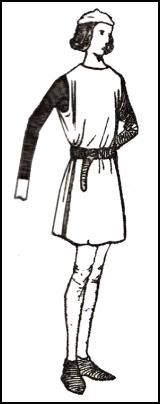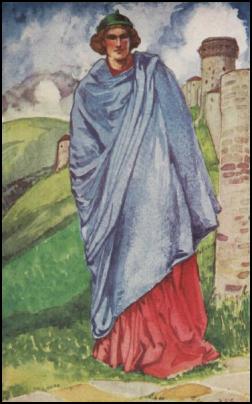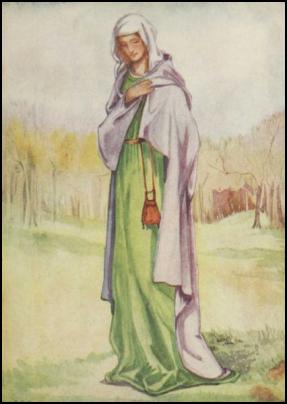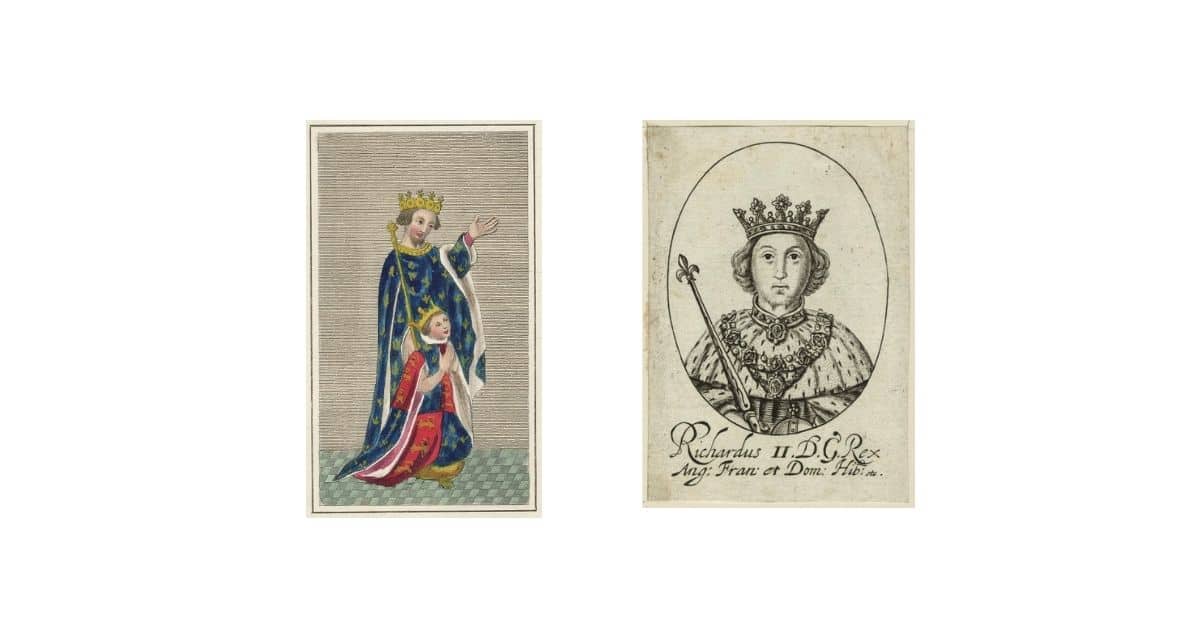

 This costume history information consists of Pages 67 to 75 of the chapter on 13th century dress in the era of Henry The Third 1216 -1272 and taken from English Costume by Dion Clayton Calthrop.
This costume history information consists of Pages 67 to 75 of the chapter on 13th century dress in the era of Henry The Third 1216 -1272 and taken from English Costume by Dion Clayton Calthrop.
Medieval Male Outfits - 1200's Fashion
 Despite the fact that historians allude to the extravagance of this reign, there is little in the actual form of the costume to bear out the idea. Extravagant it was in a large way, and costly for one who would appear well dressed; but the fopperies lay more in the stuffs than in the cut of the garments worn.
Despite the fact that historians allude to the extravagance of this reign, there is little in the actual form of the costume to bear out the idea. Extravagant it was in a large way, and costly for one who would appear well dressed; but the fopperies lay more in the stuffs than in the cut of the garments worn.
Draped Fashions
It was an age of draperies. This age must call up pictures of bewrapped people swathed in heavy cloaks of cloth of Flanders dyed with the famous Flemish madder dye; of people in silk cloaks and gowns from Italy; of people in loose tunics made of English cloth.Long Reign - Slow Fashion
This long reign of over fifty years is a transitional period in the history of clothes, as in its course the draped man developed very slowly towards the coated man, and the loose-hung clothes very gradually began to shape themselves to the body. The transition from tunic and cloak and Oriental draperies is so slow and so little marked by definite change that to the ordinary observer the Edwardian cotehardie seems to have sprung from nowhere: man seems to have, on a sudden, dropped his stately wraps and mantles and discarded his chrysalis form to appear in tight lines following the figure - a form infinitely more gay and alluring to the eye than the ponderous figure that walks through the end of the thirteenth century. Up to and through the time from the Conquest until the end of Henry III.'s reign the clothes of England appear - that is, they appear to me - to be lordly, rich, fine, but never courtier-like and elegant.A Man of The Time Of Henry III - 1216-1272 - Medieval Costumes for men

Cotehardie
Then dawned the fourteenth century- the youth of clothes - and our fashion boy shot up, dropped his mantles and heaviness, and came out from thence slim and youthful in a cotehardie. Of such a time as this it is not easy to say the right and helpful thing, because, given a flowing gown and a capacious mantle, imagination does the rest. Cut does not enter into the arena.§
Gowns In Brilliant Colours
Imagine a stage picture of this time: a mass of wonderful, brilliant colours - a crowd of men in long, loose gowns or surcoats; a crowd of ladies in long, loose gowns; both men and women hung with cloaks or mantles of good stuffs and gay colours. A background of humbler persons in homespun tunics with cloth or frieze hoods over their heads.The Fop
Here and there a fop - out of his date, a quarter-century before his time - in a loose coat with pocket-holes in front and a buttoned neck to his coat, his shoes very pointed and laced at the sides, his hair long, curled, and bound by a fillet or encompassed with a cap with an upturned brim.The Surcoat
 The beginning of the coat was this: the surcoat, which up till now was split at both sides from the shoulder to the hem, was now sewn up, leaving only a wide armhole from the base of the ribs to the shoulder. This surcoat was loose and easy, and was held in at the waist by a belt. In due time a surcoat appeared which was slightly shaped to the figure, was split up in front instead of at the sides, and in which the armholes were smaller and the neck tighter, and fastened by two or three buttons. In front of this surcoat two pocket-holes showed. This surcoat was also fastened by a belt at the waist.
The beginning of the coat was this: the surcoat, which up till now was split at both sides from the shoulder to the hem, was now sewn up, leaving only a wide armhole from the base of the ribs to the shoulder. This surcoat was loose and easy, and was held in at the waist by a belt. In due time a surcoat appeared which was slightly shaped to the figure, was split up in front instead of at the sides, and in which the armholes were smaller and the neck tighter, and fastened by two or three buttons. In front of this surcoat two pocket-holes showed. This surcoat was also fastened by a belt at the waist.
Footwear - Point Shoes
In common with the general feeling towards more elaborate clothes, the shoes grew beyond their normal shape, and now, no longer conforming to the shape of the foot, they became elongated at the toes, and stuck out in a sharp point; this point was loose and soft, waiting for a future day when men should make it still longer and stuff it with tow and moss. Of all the shapes of nature, no shape has been so marvellously maltreated as the human foot. It has suffered as no other portion of the body has suffered: it has endured exceeding length and exceeding narrowness; it has been swelled into broad, club-like shapes; it has been artificially raised from the ground, ended off square, pressed into tight points, curved under, and finally, as to-day, placed in hard, shining, tight leather boxes. All this has been done to one of the most beautiful parts of the human anatomy by the votaries of fashion, who have in turn been delighted to expose the curves of their bodies, the round swelling of their hips, the beauties of their nether limbs, the whiteness of their bosoms, the turn of their elbows and arms, and the rotundity of their shoulders, but who have, for some mysterious reasons, been for hundreds of years ashamed of the nakedness of their feet.Medieval Male Outfits
Let me give a wardrobe for a man of this time. A hood with a cape to it; the peak of the hood made full, but about half a hand's breadth longer than necessary to the hood; the cape cut sometimes at the edge into a number of short slits. A cap of soft stuff to fit the head, with or without an upturned brim. A fillet of silk or metal for the hair. A gown made very loose and open at the neck, wide in the body, the sleeves loose or tight to the wrist. The gown long or short, on the ground or to the knee, and almost invariably belted at the waist by a long belt of leather with ornamental studs. A surcoat split from shoulder to hem, or sewn up except for a wide armhole. A coat shaped very slightly to the figure, having pocket-holes in front, small armholes, and a buttoned neck. A great oblong-shaped piece of stuff for a cloak, or a heavy, round cloak with an attached hood. Tights of cloth or sewn silk - that is, pieces of silk cut and sewn to the shape of the leg. Shoes with long points - about 2 inches beyond the toes - fastened by a strap in front, or laced at the sides, or made to pull on and fit at the ankle, the last sometimes with a V-shaped piece cut away on either side. There was a tendency to beads, and a universal custom of long hair. In all such clothes as are mentioned above every rich stuff of cloth, silk, wool, and frieze may be used, and fur linings and fur hats are constant, as also are furred edges to garments. There was a slight increase of heraldic ornament, and a certain amount of foreign diaper patterning on the clothes.Women in 1200
Medieval Women Makeup
Now the lady must needs begin to repair the ravages of time and touch the cheek that no longer knows the bloom of youth with - rouge. This in itself shows the change in the age. Since the Britons - poor, simple souls - had sought to embellish Nature by staining themselves blue with woad and yellow with ochre, no paint had touched the faces of the fashionable until this reign. Perhaps discreet historians had left that fact veiled, holding the secrets of the lady's toilet too sacred for the black of print; but now the murder came out. The fact in itself is part of the psychology of clothes. Paint the face, and you have a hint towards the condition of fashion. Again, as in the case of the men, no determined cut shows which will point to this age as one of such and such a garment or such an innovation, but - and this I would leave to your imagination - there was a distinction that was not great enough to be a difference.A WOMAN OF THE TIME OF HENRY III - 1216-1272
Right - This costume plates shows the very slight changes in a woman's dress. The woman wears a plain cloak, a plain gown, and a wimple over the head. A lady would have worn clothes and shoes of richer cloth.
The gowns were loose and flowing, and were gathered in at the waist by a girdle, or, rather, a belt, the tongue of which hung down in front; but as the end of the reign approached, the gowns were shaped a little more to the figure.
A Lady
A lady might possess such clothes as these: the gowns I have mentioned above, the sleeves of which were tight all the way from the shoulder to the wrist, or were loose and cut short just below the elbow, showing the tight sleeves of the under-gown. Shoes very elaborately embroidered and pointed at the toes. A rich cloak made oblong in shape and very ample in cut. A shaped mantle with strings to hold it together over the shoulders. For the head a wimple made of white linen or perhaps of silk; this she would put above her head, leaving the neck bare. A long belt for her waist, and, if she were a great lady, a pair of gloves to wear or stick into her belt. HENRY THE THIRD Reigned fifty-six years: 1216-1272. Born 1207. Married, 1236, to Eleanor of Provence. This costume history information consists of Pages 67 to 75 of the chapter on 13th century dress in the era of Henry The Third 1216 -1272 and taken from English Costume by Dion Clayton Calthrop. The 36 page section consists of a text copy of the book ENGLISH COSTUME PAINTED & DESCRIBED BY DION CLAYTON CALTHROP. Visuals, drawings and painted fashion plates in the book have a charm of their own and are shown amid the text. The book covers both male and female dress history of over 700 years spanning the era 1066-1830. This page is about dress in the long 56 year reign of King Henry The Third 1216 -1272 . For the Introduction to this book see this introduction written by Dion Clayton Calthrop. I have adjusted the images so they are mostly 400 pixels high and can be used for colouring worksheets where pupils add some costume/society facts. My comments are in italics. You have been reading English Costume History at www.fashion-era.com © from the chapter on Henry The Third 1216-1272 from Dion Clayton Calthrop's book English Costume. Page Added 5 August 2010. Ref:-P790.NEXT - THE COUNTRY FOLK
Sitemap
- Costume History Home
- 1066-1216 Norman
- 1272-1485 Plantagenet
- 1216-1272 Henry III
- 1066-1272 Peasants' Costume - End of the Fourteenth Century
- 1272-1307 Edward I
- 1307-1327 Edward II
- 1327-1377 Edward III
- 1377-1399 Richard II
- 1399-1413 Henry IV
- 1400 Chaucer's Medieval Dress
- 1413-1422 Henry V
- 1422-1461 Henry VI
- 1461-1483 Edward IV
- 1483-1485 Richard III
- 1485-1603 Tudor
- 1603-1714 Stuart
- 1603-1830 Hanover
- Chambre Syndicale
- Theories of Fashion
